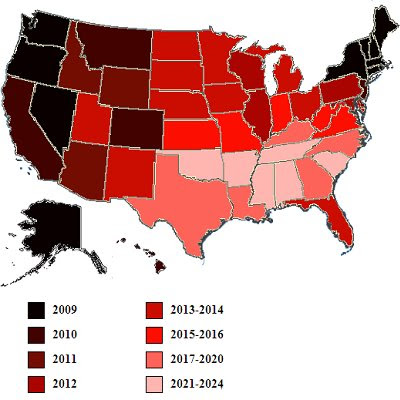 The years indicated are those by which a gay marriage ban would be defeated by voters in a given state, according to a regression model designed by Silver. His model included three variables: the year in which an anti-marriage amendment was voted on, the percentage of adults who said religion played an important part in their lives, and the percentage of white evangelicals in the state.
The years indicated are those by which a gay marriage ban would be defeated by voters in a given state, according to a regression model designed by Silver. His model included three variables: the year in which an anti-marriage amendment was voted on, the percentage of adults who said religion played an important part in their lives, and the percentage of white evangelicals in the state.
In some states a ban would already be expected to fail; New England and New York and some Western states. There is more explanation at the link above. Where Alabama stands is below.
The Winner Answers the Question
Miss USA 2009 Kristen Dalton was on the Today Show yesterday and was asked the same question that Miss California was asked during the competition. Granted, Kristen had time to think about it, but...
The Present
Here is some information about same sex couples in Alabama, from Williams Institute. Here is the Alabama Snapshot. This information is based on 2005 data, so there are probably more same sex couples now.
My comment, up front, is that the actual numbers of same sex couples and GLB individuals in the state are probably higher, since a number of people still tend to hide or deny their sexual orientation, yet I doubt many lie and claim to be gay when they are not.
There were 8,602 same sex couples living in Alabama in 2005. There were 94, 639 gay, lesbian or bisexual individuals (single or coupled) in the state. That's about 2% of the population.
The demographics are interesting. Individuals in same sex couples are, on average, 41 years old, and are significantly younger than individuals in married opposite sex relationships. Does that mean that gays are able to fall in love and commit to one another at an an earlier age than straights (or does it mean that we break up earlier, which could be in part due to lack of legal recognition and the sense of permanency that goes with it)?
Same sex couples live in every county in the state, with Jefferson County having the most (1488 couples, 0.57% of all households), followed by Mobile County (800, 0.53%), and Madison County (430, 0.39%).
Here's a surprise: the counties with the highest percentage of same sex households are Perry (0.72%), Hale (0.64%), Choctaw (0.63%) and Bullock (0.63%).
Individuals in same sex relationships are more likely to be employed (66%) than individuals in married opposite sex relationships (63%).
Individuals in same sex relationships are more likely to have a college education, (23%) compared to married individuals (21%).
Individuals in same sex relationships are less likely to have served in the military (7%) than married individuals (17%).
About 25% of same sex couples are raising children under the age of 18, (about 3,309 children).
Conclusion
Same sex couples are a significant part of Alabama demographics and will eventually have their relationships recognized. I predict it will be sooner than the 2024 prediction by Silver.

1 comment:
I cannot wait unitl Pennsylvania and Maryland join in!
Post a Comment